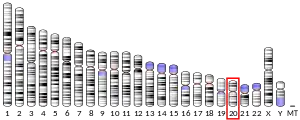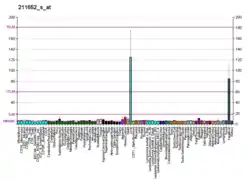Lipopolysaccharide binding protein
Lipopolysaccharide binding protein (LBP) is a protein that in humans is encoded by the LBP gene.[5][6]
LBP is a soluble acute-phase protein that binds to bacterial lipopolysaccharide (or LPS) to elicit immune responses by presenting the LPS to important cell surface pattern recognition receptors called CD14 and TLR4.[7]
The protein encoded by this gene is involved in the acute-phase immunologic response to gram-negative bacterial infections. Gram-negative bacteria contain a glycolipid, lipopolysaccharide (LPS), on their outer cell wall. Together with bactericidal permeability-increasing protein (BPI), the encoded protein binds LPS and interacts with the CD14 receptor, probably playing a role in regulating LPS-dependent monocyte responses. Studies in mice suggest that the encoded protein is necessary for the rapid acute-phase response to LPS but not for the clearance of LPS from circulation. This protein is part of a family of structurally and functionally related proteins, including BPI, plasma cholesteryl ester transfer protein (CETP), and phospholipid transfer protein (PLTP). Finally, this gene is found on chromosome 20, immediately downstream of the BPI gene.[6]
Clinical significance
LBP exposure induces LBP production.[8] LBP is synthesized by the liver, adipose tissue, and intestinal cells.[8] Dietary glucose and saturated fats acutely increase plasma LBP.[8]
The proinflammatory activity of plasma LPS is increased by LBP, which is higher in obesity.[9]
Plasma LBP is used as a better biomarker of plasma LPS than LPS itself due to the short half-life of LPS.[8]
Interactions
Lipopolysaccharide-binding protein has been shown to interact with CD14, TLR2, TLR4 and the co-receptor MD-2.[10][11][12]
References
- GRCh38: Ensembl release 89: ENSG00000129988 - Ensembl, May 2017
- GRCm38: Ensembl release 89: ENSMUSG00000016024 - Ensembl, May 2017
- "Human PubMed Reference:". National Center for Biotechnology Information, U.S. National Library of Medicine.
- "Mouse PubMed Reference:". National Center for Biotechnology Information, U.S. National Library of Medicine.
- Gray PW, Corcorran AE, Eddy RL Jr, Byers MG, Shows TB (March 1993). "The genes for the lipopolysaccharide binding protein (LBP) and the bactericidal permeability increasing protein (BPI) are encoded in the same region of human chromosome 20". Genomics. 15 (1): 188–90. doi:10.1006/geno.1993.1030. PMID 8432532.
- "Entrez Gene: LBP lipopolysaccharide binding protein".
- Muta T, Takeshige K (2001). "Essential roles of CD14 and lipopolysaccharide-binding protein for activation of toll-like receptor (TLR)2 as well as TLR4 Reconstitution of TLR2- and TLR4-activation by distinguishable ligands in LPS preparations". Eur. J. Biochem. 268 (16): 4580–9. doi:10.1046/j.1432-1327.2001.02385.x. PMID 11502220.
- Djuric Z (2017). "Obesity-associated cancer risk: the role of intestinal microbiota in the etiology of the host proinflammatory state". Translational Research. 179: 155–167. doi:10.1016/j.trsl.2016.07.017. PMC 5164980. PMID 27522986.
- Tuomi K, Logomarsino JV (2016). "Bacterial Lipopolysaccharide, Lipopolysaccharide-Binding Protein, and Other Inflammatory Markers in Obesity and After Bariatric Surgery". Metabolic Syndrome and Related Disorders. 14 (6): 279–288. doi:10.1089/met.2015.0170. PMID 27228236.
- Thomas, Celestine J; Kapoor Mili; Sharma Shilpi; Bausinger Huguette; Zyilan Umit; Lipsker Dan; Hanau Daniel; Surolia Avadhesha (November 2002). "Evidence of a trimolecular complex involving LPS, LPS binding protein and soluble CD14 as an effector of LPS response". FEBS Lett. 531 (2): 184–8. doi:10.1016/S0014-5793(02)03499-3. ISSN 0014-5793. PMID 12417309. S2CID 25135963.
- Yu, B; Wright S D (1995). "LPS-dependent interaction of Mac-2-binding protein with immobilized CD14". J. Inflamm. 45 (2): 115–25. ISSN 1078-7852. PMID 7583357.
- Erridge, C; Pridmore, A; Eley, A; Stewart, J; Poxton, IR (2004). "Lipopolysaccharides of Bacteroides fragilis, Chlamydia trachomatis and Pseudomonas aeruginosa signal via toll-like receptor 2". Journal of Medical Microbiology. 53 (Pt 8): 735–40. doi:10.1099/jmm.0.45598-0. PMID 15272059.
Further reading
- Schumann RR, Leong SR, Flaggs GW, et al. (1990). "Structure and function of lipopolysaccharide binding protein". Science. 249 (4975): 1429–31. Bibcode:1990Sci...249.1429S. doi:10.1126/science.2402637. PMID 2402637.
- Wilde CG, Seilhamer JJ, McGrogan M, et al. (1994). "Bactericidal/permeability-increasing protein and lipopolysaccharide (LPS)-binding protein. LPS binding properties and effects on LPS-mediated cell activation". J. Biol. Chem. 269 (26): 17411–6. doi:10.1016/S0021-9258(17)32454-7. PMID 7517398.
- Park CT, Wright SD (1996). "Plasma lipopolysaccharide-binding protein is found associated with a particle containing apolipoprotein A-I, phospholipid, and factor H-related proteins". J. Biol. Chem. 271 (30): 18054–60. doi:10.1074/jbc.271.30.18054. PMID 8663389.
- Nanbo A, Nishimura H, Nagasawa S (1997). "Lipopolysaccharide binding protein from normal human plasma purified with high efficiency". Protein Expr. Purif. 10 (1): 55–60. doi:10.1006/prep.1996.0712. PMID 9179291.
- Hubacek JA, Büchler C, Aslanidis C, Schmitz G (1997). "The genomic organization of the genes for human lipopolysaccharide binding protein (LBP) and bactericidal permeability increasing protein (BPI) is highly conserved". Biochem. Biophys. Res. Commun. 236 (2): 427–30. doi:10.1006/bbrc.1997.6970. PMID 9240454.
- Jack RS, Fan X, Bernheiden M, et al. (1997). "Lipopolysaccharide-binding protein is required to combat a murine gram-negative bacterial infection". Nature. 389 (6652): 742–5. Bibcode:1997Natur.389..742J. doi:10.1038/39622. PMID 9338787. S2CID 205027151.
- Kirschning CJ, Au-Young J, Lamping N, et al. (1998). "Similar organization of the lipopolysaccharide-binding protein (LBP) and phospholipid transfer protein (PLTP) genes suggests a common gene family of lipid-binding proteins". Genomics. 46 (3): 416–25. doi:10.1006/geno.1997.5030. PMID 9441745.
- Beamer LJ, Carroll SF, Eisenberg D (1998). "The BPI/LBP family of proteins: a structural analysis of conserved regions". Protein Sci. 7 (4): 906–14. doi:10.1002/pro.5560070408. PMC 2143972. PMID 9568897.
- Sato M, Saeki Y, Tanaka K, Kaneda Y (1999). "Ribosome-associated protein LBP/p40 binds to S21 protein of 40S ribosome: analysis using a yeast two-hybrid system". Biochem. Biophys. Res. Commun. 256 (2): 385–90. doi:10.1006/bbrc.1999.0343. PMID 10079194.
- Vreugdenhil AC, Dentener MA, Snoek AM, et al. (1999). "Lipopolysaccharide binding protein and serum amyloid A secretion by human intestinal epithelial cells during the acute phase response". Journal of Immunology. 163 (5): 2792–8. PMID 10453023.
- Vesy CJ, Kitchens RL, Wolfbauer G, et al. (2000). "Lipopolysaccharide-Binding Protein and Phospholipid Transfer Protein Release Lipopolysaccharides from Gram-Negative Bacterial Membranes". Infect. Immun. 68 (5): 2410–7. doi:10.1128/IAI.68.5.2410-2417.2000. PMC 97439. PMID 10768924.
- Labéta MO, Vidal K, Nores JE, et al. (2000). "Innate Recognition of Bacteria in Human Milk Is Mediated by a Milk-Derived Highly Expressed Pattern Recognition Receptor, Soluble Cd14". J. Exp. Med. 191 (10): 1807–12. doi:10.1084/jem.191.10.1807. PMC 2193148. PMID 10811873.
- Dentener MA, Vreugdenhil AC, Hoet PH, et al. (2000). "Production of the acute-phase protein lipopolysaccharide-binding protein by respiratory type II epithelial cells: implications for local defense to bacterial endotoxins". Am. J. Respir. Cell Mol. Biol. 23 (2): 146–53. doi:10.1165/ajrcmb.23.2.3855. PMID 10919979.
- Nagaoka I, Hirota S, Niyonsaba F, et al. (2001). "Cathelicidin family of antibacterial peptides CAP18 and CAP11 inhibit the expression of TNF-alpha by blocking the binding of LPS to CD14(+) cells". Journal of Immunology. 167 (6): 3329–38. doi:10.4049/jimmunol.167.6.3329. PMID 11544322.
- Gutsmann T, Müller M, Carroll SF, et al. (2001). "Dual Role of Lipopolysaccharide (LPS)-Binding Protein in Neutralization of LPS and Enhancement of LPS-Induced Activation of Mononuclear Cells". Infect. Immun. 69 (11): 6942–50. doi:10.1128/IAI.69.11.6942-6950.2001. PMC 100074. PMID 11598069.
- Iovine N, Eastvold J, Elsbach P, et al. (2002). "The carboxyl-terminal domain of closely related endotoxin-binding proteins determines the target of protein-lipopolysaccharide complexes". J. Biol. Chem. 277 (10): 7970–8. doi:10.1074/jbc.M109622200. PMID 11773072.
- Deloukas P, Matthews LH, Ashurst J, et al. (2002). "The DNA sequence and comparative analysis of human chromosome 20". Nature. 414 (6866): 865–71. Bibcode:2001Natur.414..865D. doi:10.1038/414865a. PMID 11780052.
- Kaden J, Zwerenz P, Lambrecht HG, Dostatni R (2002). "Lipopolysaccharide-binding protein as a new and reliable infection marker after kidney transplantation". Transpl. Int. 15 (4): 163–72. doi:10.1007/s00147-002-0392-2. PMID 11976738. S2CID 23593715.
- Reyes O, Vallespi MG, Garay HE, et al. (2002). "Identification of single amino acid residues essential for the binding of lipopolysaccharide (LPS) to LPS binding protein (LBP) residues 86-99 by using an Ala-scanning library". J. Pept. Sci. 8 (4): 144–50. doi:10.1002/psc.375. PMID 11991204. S2CID 28803013.
External links
- lipopolysaccharide-binding+protein at the US National Library of Medicine Medical Subject Headings (MeSH)
This article incorporates text from the United States National Library of Medicine, which is in the public domain.





